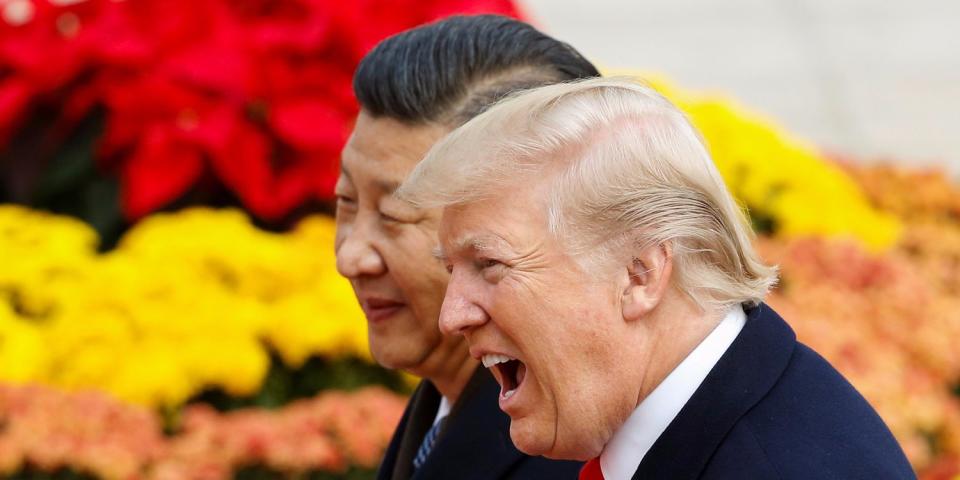China hits back at Trump with tariffs on $60 billion of US goods

REUTERS/Thomas Peter
China on Tuesday hit back at the US by announcing tariffs on $60 billion worth of US goods.
China's Ministry of Commerce said earlier Tuesday that it had "no choice" but to retaliate.
On Monday evening, the US announced new tariffs on $200 billion worth of Chinese goods.
China's new tariffs affect 5,207 US products and account for as much as 95% of all US exports to China.
China has hit back at the US with a fresh series of tariffs less than 24 hours after President Donald Trump announced new tariffs on $200 billion worth of Chinese goods, knocking the trade war between the two nations up another gear.
The Chinese Ministry of Commerce on Tuesday said it would levy tariffs of 5% to 10% on $60 billion worth of US goods sent to China, with 5,207 individual products affected. The tariffs are to take effect September 24, the same day the latest ones imposed by the US are scheduled to begin.
"In order to safeguard its legitimate rights and interests and the global free trade order, China will have to retaliate as a response," a statement from the ministry said earlier Tuesday, before the specifics of the retaliation were released.
The Trump administration initiated the latest round in the US-China trade war overnight. When the new tariffs take effect, over half of all Chinese goods coming into the US will be subject to duties. The US has sought to use tariffs to pressure Beijing to change some of its trade practices.
"For months, we have urged China to change these unfair practices and give fair and reciprocal treatment to American companies," Trump said in a statement.
"We have been very clear about the type of changes that need to be made, and we have given China every opportunity to treat us more fairly. But, so far, China has been unwilling to change its practices."
The new tariffs from Beijing are in line with what the ministry previously threatened, and they mean 85% to 95% of American exports to China are now facing tariffs.
Trump's new tariffs threaten to derail plans to send Chinese President Xi Jinping's top economic adviser to the US for trade talks. The South China Morning Post reports that plans to send Vice Premier Liu He for meetings with senior US officials may now be scrapped. The Wall Street Journal later reported that China could continue with the meetings, but send vice commerce minister Wang Shouwen instead of Liu.
"We have been stressing that talks need to happen on the basis of parity, equality, and good faith," a representative from the Chinese Foreign Ministry said at a press briefing, according to the Financial Times.
"What the US has done shows no sincerity and good faith at all."
Here's a timeline of the US-China trade war so far:
March 1: President Donald Trump announces tariffs on all imports of steel and aluminum, including metals from China.
March 22: Trump announces plans to impose a 25% tariff on $50 billion worth of Chinese goods. China announces tariffs in retaliation to the steel and aluminum duties and promises a response to the latest US announcement.
April 3: The US trade representative announces a list of Chinese goods subject to the tariffs. There is a mandatory 60-day comment period for industries to ask for exemptions from the tariffs.
April 4: China rolls out a list of more than 100 US goods worth roughly $50 billion that are subject to retaliatory tariffs.
May 21: After a meeting, the two countries announce the outline of a trade deal to avoid the tariffs.
May 29: The White House announces that the tariffs on $50 billion worth of Chinese goods will move forward, with the final list of goods released June 15. The move appears to wreck the nascent trade deal.
June 15: Trump rolls out the final list of goods subject to new tariffs. Chinese imports worth $34 billion would be subject to the new 25% tariff as of July 6, with another $16 billion worth of imports subject to the tariff at a later date. China retaliates with an equivalent set of tariffs.
June 18: Trump threatens a 10% tariff on another $200 billion worth of Chinese goods.
July 6: The first tranche of tariffs on $34 billion worth of Chinese goods takes effect; China responds in kind.
July 10: The US releases an initial list of an additional $200 billion worth of Chinese goods that could be subject to a 10% tariff.
August 1: Washington more than doubles the value of its tariff threats against Beijing, announcing plans to increase the size of proposed duties on $200 billion worth of Chinese goods to 25% from 10%.
August 3: China says it will impose tariffs of various rates on another $60 billion worth of US goods if Trump moves forward with his latest threat.
August 7: The US announces that the second tranche of tariffs, which will hit $16 billion worth of Chinese goods, will go into effect on August 23.
August 23: The US imposes tariffs on another $16 billion worth of Chinese goods, and Beijing responds with tariffs on $16 billion worth of US goods.
September 7: Trump says the tranche of tariffs on $200 billion worth of Chinese goods is coming "soon" and threatens to impose tariffs on another $267 billion worth of Chinese goods.
September 17: Trump announces 10% tariffs on $200 billion worth of Chinese goods, saying China has "been unwilling to change its practices."
September 18: China says it has "no choice" but to retaliate to the fresh tariffs "to safeguard its legitimate rights and interests." It announces tariffs on $60 billion worth of US goods sent to China.
NOW WATCH: An aerospace company reintroduced its precision helicopter with two crossing motors
See Also:

 Yahoo Finance
Yahoo Finance 